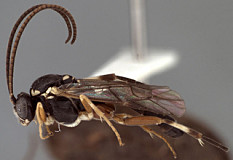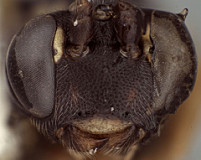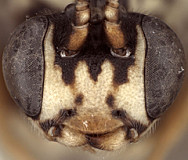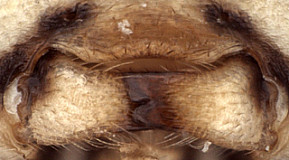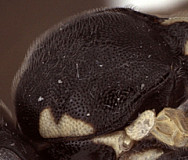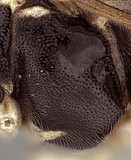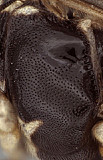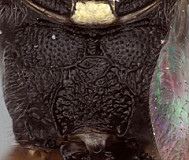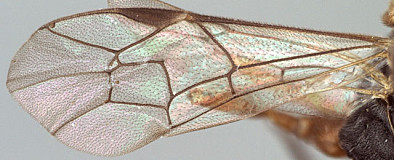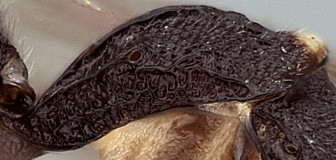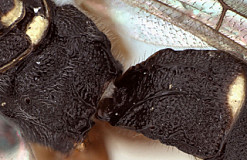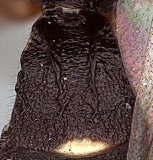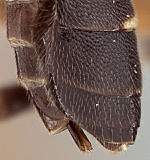Clypeus (Figs 2, 3) somewhat narrow, with surface finely punctate; ventral margin thickened, blunt and evenly convex throughout (Figs 2, 3); epistomal sulcus narrow, distinct; clypeus in profile essentially flat. Inner eye margins parallel. Malar space (Fig. 3) slightly more than 0.5 times basal width of mandible; malar sulcus absent. Mandible (Fig. 4) broad, gradually tapering from base to apex; dorsal tooth broader than ventral tooth, though both are broad and about equal in length; ventral margin distinctly carinate. Antenna (Fig. 5) equal to or slightly shorter than body, first flagellomere short relative to species in genera such as
Mesoleptidea and
Hadrodactylus, basal flagellomeres somewhat shorter and broader in female than male. Epomia not evident. Epicnemial carina greatly reduced, weak and only present ventrally when discernible, not reaching anterior margin of mesopleuron (Figs 7, 8). Notaulus (Fig. 6) present as a weakly impressed groove on anterior declivity. Propodeum (Fig. 9) with median longitudinal carinae very well-developed, forming flask-shaped median section with large rugulose petiolar area similar to that in
Synomelix petiolar area and areola confluent but separated from basal median area by a distinct transverse carina; lateral longitudinal carina and transverse carinae weaker, the latter sometimes absent. Posterior hind tibial spur as in Fig. 1; fifth tarsomere of hing leg normal, not unusually elongate (relative to fourth). Fore wing (Fig. 6) with areolet present; stigma moderately broad, Rs+2r near basal third. Hind wing with first abscissa of CU1 approximately equal in length to 1cu-a. T1 (Figs 11-13) relatively short and broad, ventral margin nearly straight in profile; dorsal carinae distinctly elevated and extending posteriorly about half distance between spiracle and posterior margin; basal depression at dorsal tendon attachment broad, shallow; dorsal-lateral carina somewhat obscured by adjacent sculpture (Fig. 11); glymma absent. T2 thyridium readily visible (Fig. 14). Ovipositor and sheath (Fig. 14) straight, ovipositor with distinct dorsal, subapical notch.
The description is modified from Townes (1970), based on the images presented here from specimens in the Canadian National Collection.
1.
Hypsantyx lituratoria habitus male...
Hypsantyx lituratoria habitus male
↰
↴
2.
Hypsantyx lituratoria female fa...
Hypsantyx lituratoria female face
↰
↴
3.
Hypsantyx lituratoria face, m...
Hypsantyx lituratoria face, male
↰
↴
4.
Hypsantyx lituratoria mandibles...
Hypsantyx lituratoria mandibles male
↰
↴
5.
Hypsantyx lituratoria antenna, female...
Hypsantyx lituratoria antenna, female
↰
↴
7.
Hypsantyx liturato...
Hypsantyx lituratoria
↰
↴
8.
Hypsantyx lit...
Hypsantyx lituratoria
↰
↴
9.
Hypsantyx lituratoria propode...
Hypsantyx lituratoria propodeum
↰
↴
10.
Hypsantyx lituratoria wings...
Hypsantyx lituratoria wings
↰
↴
11.
Hypsantyx lituratoria T1, femal...
Hypsantyx lituratoria T1, female
↰
↴
12.Hypsantyx lituratoria T1, female
13.
Hypsantyx lituratoria ...
Hypsantyx lituratoria T1, female
↰
↴
14.
Hypsantyx ...
Hypsantyx lituratoria metasoma dorsal, female
↰
↴
15.
Hypsantyx lituratoria ...
Hypsantyx lituratoria apex of metasoma showing ovipositor sheath
↰
↴

